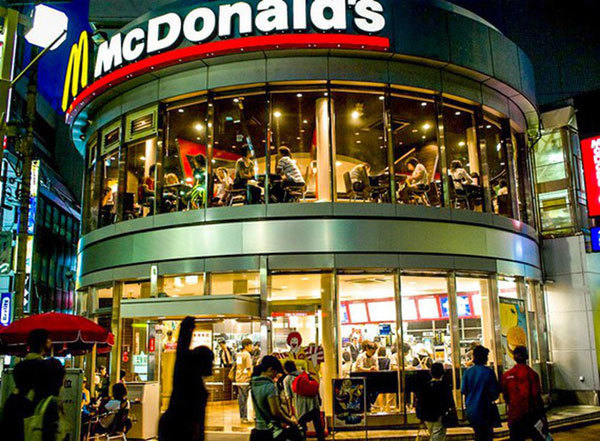
It was late afternoon and the traffic was busy. Nguyen Thu Thuy in Hoang Mai district in Hanoi stopped her motorbike at a crossroads and went to the sidewalk to buy three pieces of fried chicken. This was chicken of a brand favored by her children.
Each of the steaming hot fried chicken pieces was priced at only VND22,000. Thuy felt satisfied about the price. She also felt happy because she could buy things her children like, and did not have to spend time parking and queuing at shopping centers. For busy women like Thuy, buying food on the sidewalk is convenient.
“Previously, you had to park your motorbike, enter shops to order food and wait quite a while. Now you just sit on your motorbike and sellers will give food to you,” she explained.
Not only fried chicken, but pizza brands now are also selling this way. In Linh Dam residential quarter, small-size pizzas bearing famous brands now sell on sidewalks, which can more easily attract buyers. One pizza sells for less than VND100,000.
Analysts noted that there is a "going down the street" trend, with one well-known café chain and one fried chicken and pizza brand now selling products in containers in residential quarters.
McDonald’s applied the model even before the Covid-19 pandemic broke out in HCM City. It set a kiosk selling hamburgers and coffee in front of its shops on Hoang Dieu Street in district 4.
Otoke Chicken has also set up some stalls in front of its shops in HCM City to serve breakfast, where it mostly sells hamburger and coffee.
Unlike their shops, the kiosks on the sidewalks only open at certain hours and target busy customers such as office workers. There are also fewer choices on the menus. However, sidewalk kiosks have their own advantages, including reasonable prices and convenience.
Popular fast food brands, from KFC to McDonald’s, from Otoke Chicken to Pizza Hut, are selling food both directly to customers on sidewalks and at shops located in the most advantageous positions in the city.
| Unlike their shops, the kiosks on the sidewalks only open at certain hours and target busy customers such as office workers. There are also fewer choices on the menus. However, sidewalk kiosks have their own advantages, including reasonable prices and convenience. |
Pavements are usually the places for small retailers and street shops only, while large premises are reserved for big brands who have enough money to pay for high rentals. However, things are different now.
As fast-food chains are now under pressure from increasing rents and a decreasing number of customers, they have no other choice than to try a new sales model to improve their income. They sell food on streets, neglecting the whispers about strong brands having to struggle to survive.
Analysts say that fast food brands are facing difficulties. A South Korean newspaper reported that the Lotteria fast food chain was planning to withdraw from Southeast Asia. Lotte GRS stopped its fast food chain in Indonesia. The food material supplier of Lotte in Vietnam, established in early 2020 with an aim of expanding Lotte GRS operation in neighboring countries, was also in a closure process. However, this information was denied by Lotteria.
Joining the Vietnamese market early, in 1998, Lotteria was one of the fastest growing fast food chains in Vietnam.
Burger King entered Vietnam in 2012 with a plan to open 60 shops nationwide. Two years later, McDonald’s turned up with a plan to open 100 shops within 10 years. However, Burger King has shut down five shops in Hanoi, HCM City and Da Nang.
‘Going down the street’ appears to be a trend when competition becomes stiff and sellers have to find ways to reduce expenses amid Covid-19. Mobile sales have become the choice of many food chains because it allows them to save money on rent.
According to JLL Vietnam, many big Vietnamese food chains are also trying to sell products via kiosks and vending machines on streets as a way to pilot the sale of takeaway food items. With this trial, they don’t have to worry too much about money to hire workers and rental space.
Ong Bau coffee chain is an example. From the very beginning, the owners of Ong Bau planned to sell coffee from vending machines. There are now 39 such machines bearing Ong Bau brand, mostly in Hanoi, HCM City and Can Tho.
However, an analyst noted that the new sales model is ineffective as it depends too heavily on the positions of shops. Such kiosks have not nee' replicated by other chains.
However, he stressed that as the model has a lot of advantages, including convenience which is highly appreciated by busy customers, including young people, and it will continue to develop in the time to come.
Duy Anh

Foreign food chains unable to sustain in Vietnamese market
Vietnam has for many years been considered as an attractive market for the retail industry, including fast foods and beverages.

Expanding fast food outlets place strain on obesity worry
As international organisations are at pains to warn of an increasing obesity problem in Vietnam, the country’s fast food industry continues to swell despite mounting losses for some chains and difficulties in attempting to alter local eating norms.
